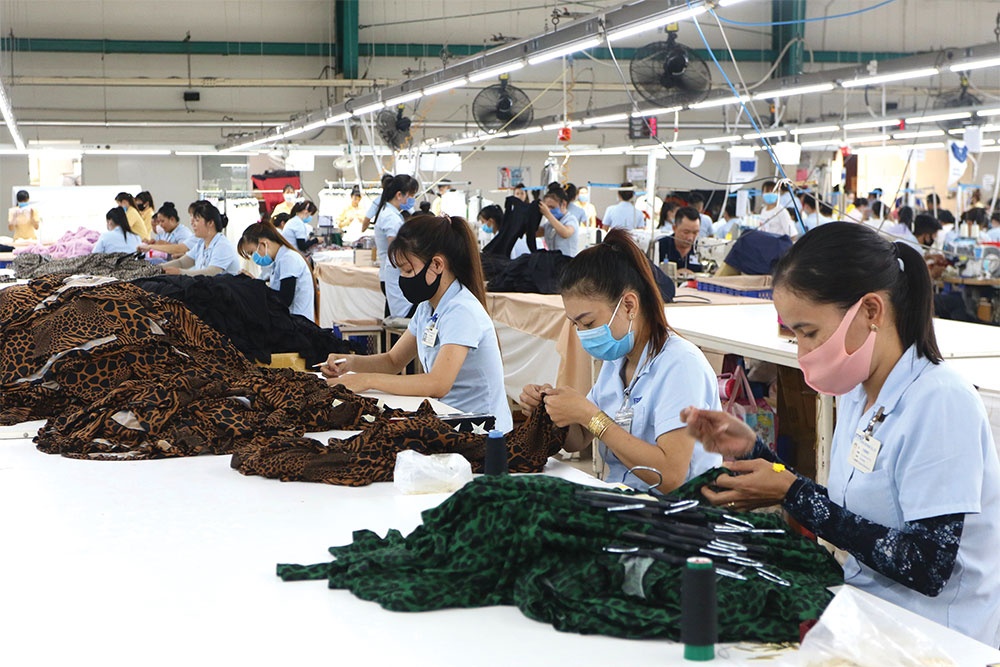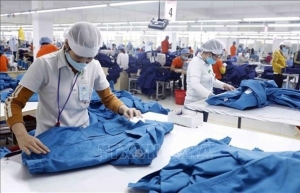Apparel groups under supply chain pressure
 |
| Firms in textiles, footwear, and more are striving to adhere to strict regulations from the likes of the EU, Photo: Le Toan |
This year, it is anticipated that Garment 10 Corporation will restore 30-35 per cent of its overall sales from the European market. Due to the gradual recovery of this market and the less stringent guidelines on fabric sources in the EU-Vietnam Free Trade Agreement (EVFTA) than for yarn in the Comprehensive and Progressive Agreement for Trans-Pacific Partnership, the plan for Garment 10 is deemed viable.
Once the EU concludes trilateral discussions and votes on the regulation on identifying the origin of imported textile and footwear items in May, changes may be ahead for Vietnam, the world’s third-largest garment exporter after China and Bangladesh.
“Tracking the supply chain is not straightforward since brands do not bear responsibility with producers,” said Nguyen Tien Dung, director of the Quality Assurance Department at Garment 10.
Vietnam continues to rely mostly on outsourcing. Many purchasers specify the origin of raw materials, but this does not ensure the quality of imports. “In addition to labour and environmental expenditures, we must endure the expense of product quality inspection,” Dung added.
The pandemic has altered customer preferences, and some groups have even retaliated against foreign textile and footwear makers with stricter regulations. Walmart, for example, requires testing for hazardous compounds with severe implications, while Tesco wants to be able to track completed products back to the raw material stage.
However, Claudia Anselmi, vice president of the European Chamber of Commerce in Vietnam, noted that tracing the supply chain of textiles and footwear and implementing the upcoming EU directive have opened up immense opportunity as Vietnam transitions to a more sustainable economy.
“Tracking the supply chain will assist Vietnam in further building its market in the EU customer base, while also helping to differentiate it from the cohort of manufacturing nations that do not adhere to international norms. This impetus will enable Vietnam to meet its EVFTA obligations properly,” Anselmi said.
Anselmi expected that customer behaviour will alter, and they will no longer switch suppliers so often. Companies must also establish long-term partnerships with suppliers that fulfil the supply chain traceability directive’s requirements.
“Firms must increase their openness about human resources and environmental principles,” she added. “Efforts must concentrate on those, as well as combating the effects of climate change on the lives of employees, and assess the degree of investment required to get the desired outcomes.”
Annabel Meurs, head of Supply Chain Transformation at Fair Wear Foundation – a Dutch-based non-profit organisation that works to improve conditions for workers in garment factories – considers that supply chain tracking is a novel method for bringing sustained advantages to Vietnam’s apparel and footwear industries. “This would also alter the mismatch of rights and obligations between brands and manufacturers, a long-discussed topic that remains on paper,” Meurs said.
With their wealth, brands have the ability to enforce standards on producers, but they bear minimal accountability for human resources and environmental oversight. Meurs pointed out the power disparity in the existing textile and footwear value chain, whereby the producer is in a weakened state, having to shoulder the buyer’s demands as well as the majority of the duties.
“There are plenty of excellent instances of brands and manufacturers sharing responsibilities. Nonetheless, there are still many companies that do nothing and are even willing to switch suppliers if the conditions are not met,” Meurs added. “Brands should also be included in the process, and producers should not be completely accountable.”
| France and the United Kingdom have embraced national regulations on distribution network tracing and human resources, while the German government has, as of this year, implemented restrictions on tracing the origin of textile, leather, and footwear products manufactured by companies with more than 3,000 employees. Beginning in 2024, Germany will apply this legislation to enterprises with 1,000 or more workers, making it much more stringent. The United Nations published its Guiding Principles on Business and Human Rights in 2011. In 2017, the Organisation for Economic Co-operation and Development also issued guidelines for the responsible tracing of clothing and footwear supply chains. In 2022, textile and apparel exports to the European market reached $4.5 billion, representing 12 per cent of the industry’s entire export turnover. The equivalent number for the leather and footwear sector was $6.9 billion or 24.5 per cent. |
 | Textile producers prepared for barrage of disruption Vietnamese enterprises are trading well so far this year, but key exporters in textiles, garments, leather, and footwear are still suffering from increasing raw material costs. |
 | Textiles and garments must satisfy importer needs Vietnam’s textile and garment sector is developing new competitive advantages to preserve its position as the world’s third-largest exporter. Van Nguyen spoke with Vu Duc Giang, chairman of the Vietnam Textile and Apparel Association, on the subject. |
What the stars mean:
★ Poor ★ ★ Promising ★★★ Good ★★★★ Very good ★★★★★ Exceptional
Related Contents
Latest News
More News
- Double-digit GDP growth within reach with shift to higher-value expansion (January 06, 2026 | 08:33)
- Takeda Vietnam awarded for ongoing support of Vietnam’s sustainability efforts (December 31, 2025 | 21:00)
- Vietnam's retail market tops $269 billion in 2025 amid e-commerce boom (December 31, 2025 | 19:00)
- Stronger legal framework urged as trade fraud surges online (December 31, 2025 | 18:58)
- FPT exports first chip shipment to Japan (December 31, 2025 | 10:47)
- AkzoNobel rolls out sustainability campaign “It All Adds Up” for the wood sector (December 31, 2025 | 09:23)
- Textile apparel firms deliver robust earnings despite global tariff pressures (December 30, 2025 | 10:09)
- Businesses ramp up production as year-end orders surge (December 30, 2025 | 10:05)
- Vietjet chairwoman awarded Labour Hero title (December 29, 2025 | 13:06)
- How to unlock ESG value through green innovation (December 29, 2025 | 10:03)

 Tag:
Tag:



















 Mobile Version
Mobile Version